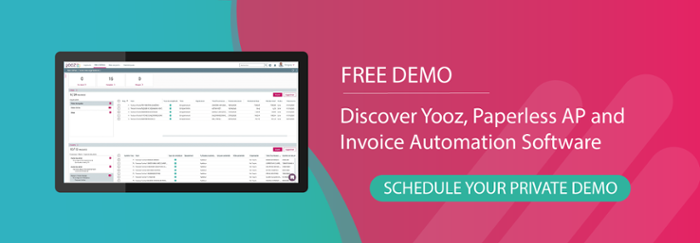Throughout history all kinds of employees have used manual labor to complete tasks and, up to a certain point, been incredibly successful. However, no matter how much the workload increased there remains only 24 hours in a day. This led to searching for better ways to complete the work and eventually, getting tasks done in record time with as little human intervention as possible.
In fact, quickly completing work with minor human intervention is one of the hallmarks of intelligent automation across many business activities, from manufacturing to accounting. But intelligent automation doesn’t just mean robots on an assembly line or robotic-like tugs finding their way around warehouses. The way that an intelligent platform for accounts payable automation handles invoices is another prime example of software making life easier, in this case for the finance function.
Auto Invoice Processing: Powerful from Purchase to Pay
It’s possible to handle multiple invoices with unimagined speed, airtight security, and do it at scale while still reeling in substantial savings in terms of both time and money. The secret lies in using a combination of Robotic Process Automation (RPA) with Artificial Intelligence (AI) and Machine Learning (ML). What does that actually mean?
RPA is a fancy term for setting up simple rules that software will follow when performing a task. AI and ML are cutting-edge algorithms that exhibit truly intelligent behavior when they handle invoices, purchase orders, and other documents.
Together, the combination forms a technological foundation of powerful automation platforms that replace time-consuming, error-prone manual data entry and record keeping typically associated with the accounts payable function. These automation platforms allow companies in any industry to process hundreds or thousands of invoices quickly, accurately, and securely from end-to-end or from procure-to-pay.
However, intelligent and comprehensive AP automation doesn’t exist in a vacuum. Instead, it is tightly integrated with the Enterprise Resource Planning (ERP) system or financial software package already in use by organizations. Thanks to digital communication over an automated invoice interface between systems that is constantly doing a dance of “push and pull” to share relevant information related to both invoices and the entire accounts payable process.
The 5 Steps of an Auto Invoice Processing
Invoice processing is the steps required from the point of receiving and invoice through paying it. Let’s take a closer look at the five main steps of intelligent automated invoice processing to better understand how a business can save time and money throughout the entire process.
1. Capture
Invoice capture, also referred to as invoice data extraction, is the first stage of the process in which invoices are received and data is extracted from the invoice image through automated methods. The invoices have many variations and types, both paper and digital format such as email attachment and PDFs. Even if you scan batches of paper invoices, the show will still go on because an advanced platform such as Yooz will be capable of automatically separating each invoice before moving it along to the next step.
- Advanced imaging capability recognizes and sorts out information.
- There is no backlog of invoices waiting to enter the system. Starting here the process runs automatically 24/7 regardless of whether somebody is physically present in the office or not.
2. Review
This is where machine learning algorithms do the hard work. Before smart AP automation, staff had to manually create and key in all relevant data points from an invoice. These included items ordered, amounts, prices, due dates, bank and tax information, addresses, and even exchange rates if the vendor was outside the US. All it too was one slip of the finger, misread information, or one too many zeros added to a number by accident to cause major problems. Simply put, manual entry into tables or spreadsheets poses a much higher risk of errors, opportunities for fraud, and even duplications.
It is at this stage where advanced technology will use a three-way process for invoice validation. It will automatically review all invoices to ensure each attribute and category is correct (such as the right GL code) and then match each invoice with a purchase order. If all the details check out, the invoice is validated and ready for final review. Exceptions, on the other hand, are automatically flagged for further review.
- Invoices are processed in seconds or minutes – occasionally hours – compared to the days and often months required in a manual process
- All information is captured, or the invoice is flagged. Incomplete invoices or those with discrepancies do not slip through any process cracks.
3. Approve
Every organization has its own rules on how to handle invoices, such as giving preference to key suppliers, routing invoices to specific staff based on certain subjects or above a certain amount, and even putting special emphasis on due dates to unlock early-pay discounts.
With an AP automation platform, those rules can be programmed and adjusted as needed to optimize cash management and any other parameters. Being able to set such rules means that your invoice processing runs even faster and smarter. In addition, with a cloud-based platform, approval can be done from anywhere, anytime, including on mobile devices. This adds yet another layer of business resilience.
- No more transporting invoices between people or worrying what happens if somebody is absent.
- In addition, with a cloud-based platform, approval can be done from anywhere, anytime, including on mobile devices. This adds yet another layer of business resilience.
4. Pay
The end – in fact the entire point – of the invoice process involves payment. If your platform is seamlessly connected to a payment partner or, even better, has an integrated payment module such as YoozPay, settling an invoice is part of the streamlined process. The AP team only must select invoices to be paid, set the amount (full or partial), and pick a manual or automated schedule. Suppliers, for their part, can be onboarded with an intuitive interface that asks them for two things: an email address and preferred payment method (virtual card, ACH, check, or paper check).
- By having a platform and process that triple checks and automatically creates a tracking record, you drive down mistakes such as erroneous payments.
- There are no payment delays and confirmation is automatically shared between systems once completed.
5. Export
Using an automated invoice interface means that everything else runs on its own behind the scenes. All the process – checking that the key values are in the relevant fields, initiating payment, confirming receipt of electronic funds on the vendor’s side – is not just tracked. The information is pushed back in to both the AP platform as well as the ERP system for reconciliation.
Depending on the ERP system used by an organization, information can be updated with an auto sync feature or via batch updates are regular intervals. Some platforms, such as Yooz, form partnerships and are supported by the platform to ensure a seamless flow of information.
- Real-time data updates not only allow for better and more strategic planning, but it can also easily improve the customer/supplier relationship.
- Each transaction is recorded which automatically simplifies any audit or evaluation process.
Is It Worth It?
The results speak for themselves. Organizations that rely on an automated invoice interface for invoice import and processing report an 80% reduction in processing costs. What’s more, cycle times will drop from weeks to days or sometimes even hours, with error rates going down as well.
Paying the right amounts on time translates into several additional benefits: capturing early-payment discounts, avoiding late fees, and not falling for erroneous, duplicate, or fraudulent invoices. This can easily turn the Accounts Payable department into a new profit center.
Having all relevant invoice data at your fingertips in one unified automated invoice processing interface also gives the entire organization better visibility into its operations and cash management. Especially when run in the cloud, an AP automation platform makes it easy to securely store and search for specific invoices, down to a keyword or amount.
This kind of digital transformation, achieved one invoice at a time, yields a detailed audit trail for later and provides a real-time stream of important data for the here and now.
Tracking an organization’s KPIs in a single browser window and using these values to develop actionable insights - that’s the essence of financial intelligence. If the AP team doesn’t have its hands tied up with chasing paper, it can focus on tracking the status of important invoices submitted by key suppliers. Paying on time thanks to intelligent automation might help you negotiate preferential terms and make your supply chain more robust.
Finally, not to be left out, by reducing the repetitive mindless work and providing an opportunity for true value-added efforts, there is an almost automatic boost in staff morale. Wouldn’t just that be reason enough?








